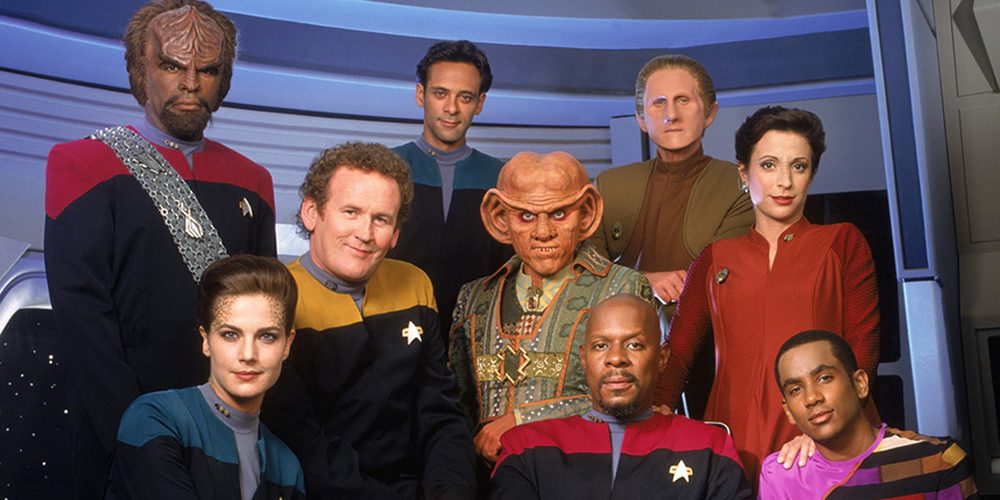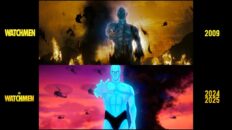“In my life I have found two things of priceless worth―learning and loving. Nothing else―not fame, not power, not achievement for its own sake―can possible have the same lasting value. For when your life is over, if you can say ‘I have learned’ and ‘I have loved,’ you will also be able to say ‘I have been happy.’” ― Arthur C. Clarke, Rama II
***
I was looking for something to revisit at the beginning of the new year that I could look at with new eyes and was considering Babylon 5, but a few friends are in the middle of re-watching Star Trek: Deep Space Nine for its 25th anniversary this year and I realized while being a fan of the show, I have never seen all the episodes, and not in chronological order. So I decided to take the plunge and will be sharing a season-by-season review of the series here.
DS9’s pilot episode, “Emissary”, firmly establishes its new characters―primarily Avery Brooks’ Commander Benjamin Sisko―and the series in the Star Trek universe as something new, something different. The few scenes between Sisko and Jean-Luc Picard (a cameo by Patrick Stewart) are powerful and a clear indicator that what fans knew of Star Trek, and especially Star Trek: The Next Generation, was going to be challenged. Sisko is torn, wanting to be a good father to his son after the loss of his mother to Picard himself while he had been part of the Borg, but also taking his position in Starfleet seriously and desiring to serve in that capacity. He is more direct and pointed than Picard, but also displays an uncanny ability to listen and engage, and allows himself a vulnerability and playfulness at times―seen during the pilot episode most clearly in the flashbacks with his deceased wife―that undercuts the image of the character that we most clearly remember.
Where the characters in TNG revered Picard for his cunning and thoughtfulness, throughout season one of DS9 we see Sisko come to be admired for his levity, directness, compassion, and approachability. Indeed, his induction by the Bajoran spiritual leader Kai Opaka as Emissary from their gods, a messianic figure to their religion, is taken equally with an almost casual indifference and with reverence to what they view him as. Looking back, it’s easy to place Brooks’ characterization here in a sort of meta context, a balancing act between an embrace of equality as a black leader and a rejection of the “magical negro.” We catch glimpses of Sisko’s leadership style and who he is as a person throughout the season, from his initial meeting with his second-in-command, Kira Nerys (Nana Visitor), a female Bajoran assigned to the space station as a liaison officer, to his dealing with adversaries such as Gul Dukat (Marc Alaimo) who goes on to become a major antagonist in the series, to his interactions with his son, Jake (Cirroc Lofton), which are often some of the most touching and profound scenes in the first season, held in stark contrast to the science fiction trappings surrounding them.
The premise of DS9 was unlike any that had come before in the Star Trek Universe, and indeed, any since. Instead of being focused on a starship, it was focused on a space station adjacent to a wormhole that allowed travel to the distant and largely unknown Gamma Quadrant and Bajor, the home planet of the Bajorans who have recently been liberated from a long occupation by the more established and often brutal Cardassians. In other words, unlike every other Star Trek series or movie, DS9 is set in a fixed location, dealing with ongoing “local” issues and encountering travelers and problems that come to them. And it also has the highest ratio of non-Starfleet officers as main characters including Kira Neyrs, chief of security Constable Odo (René Auberjonois), Jake Sisko, and Ferengi bar owner Quark (Armin Shimerman) along with his bother Rom (Max Grodénchik) and nephew Nog (Aron Eisenberg).
The main cast itself was more diverse and status quo-upending as any seen in the Star Trek universe at the time, and arguably since. A black man as commander; a woman as first officer (Nana Visitor radiates in her role as Kira Neyrs, stubbornly unwilling to be silenced as a woman or as a Bajoran, but not so hard as to show compassion and a wry sense of humor); a Sudanese born actor as Medical Officer Bashir (Alexander Siggig, birth name Siddig El Tahir El Fadil El Siddig Abdurrahman Mohammed Ahmed Abdul Karim El Mahdi); a female Chief Science Officer, Jadzia Dax (Terry Farrell), who is a host-symbiote amalgam who has lived previously as both men and women; Odo, an alien chief of security; Quark, the alien bar owner; Jake, Sisko’s son; and O’Brien (Colm Meany) as the only white male main character, a token crew member from TNG who comes into his own as a character here.
DS9’s first season is surprisingly solid, especially in comparison to TNG’s first season, taking time to introduce all of its characters and rarely stumbling. “Babel” is a particularly strong episode, early in the season, exploring themes of communication and the loss of it among such diverse characters, even if the resolution is rushed. “Q-Less” features TNG fan-favorite and Loki-like Q (John de Lancie) visiting the station and further solidifies the difference between Picard and Sisko after Sisko punches Q and declares, “I am not Picard”. “Dax” explores the character of Jadzia Dax, and what it means to be a long-living symbiote, transferred across many host lives. The episode falls a little flat as ideas and questions are presented but quickly shoveled aside for the next one. It is an interesting introduction though, and gets explored more throughout the series. It also forecasts in some ways the contemporary debate over whether Dr. Who can or should be regenerated as a woman. “Progress” is a deep dive into Kira’s character and that of the Bajoran people. And “Duet”, which features Kira interrogating a possible Cardassian war criminal, manages to single-handedly re-contextualize who the Cardassians are when viewed as a group versus who they are as individuals.
As with any Star Trek series from the era, there are a few whimsical, “what-if”, intellectually playful episodes. One, “Move Along Home”, falls flat as the premise only encourages ethical and moral considerations to be viewed as a game where nobody is ever in danger of really being hurt. But “If Wishes Were Horses” wrestles seriously with the ideas of imagination and storytelling. It posits that the stories we tell ourselves shape the world around us, and we have a responsibility to ourselves and others to choose what stories we believe and shape. It also highlights some personal touches such as Sisko’s endearing love of baseball and Bashir’s unhealthy obsession with Dax.
While the series started with an episode-of-the-week format, it would morph into one of the first serialized television dramas, changing the format of the medium to what we now expect in television programs and the age of binge-watching. The seeds of that are planted here in season one as we see Jake Sisko’s budding friendship with Ferengi Nog, O’Brien’s wife Kieko’s (Rosalind Chao) campaign to begin a school on the space station, and Kira’s and Sisko’s arcs over the season. While often compared and contrasted to the similarly serialized space station set Babylon 5, DS9’s place in both TV and Star Trek history is unique as part of a popular franchise taking new risks and directions, and as good storytelling in its own right.








